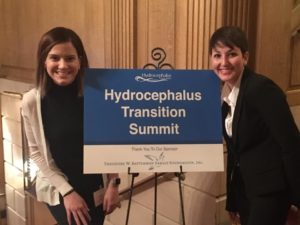Tackling Obstacles to Finding Care for Young Adults with Hydrocephalus
By Tessa van der Willigen
Board Member, Hydrocephalus Association
Co-Chair, Transition Summit
The weather in Seattle in mid-February was unusually mild and sunny, but the 60 or so participants in the Hydrocephalus Association’s Transition Summit didn’t notice. They were huddled together in a conference room surveying the disappointing state of care for young adults with hydrocephalus, discussing where the obstacles are, and looking for solutions.
The agenda for the meeting was ambitious: no less than laying the basis for transforming the ecosystem for transitional care for young adults with hydrocephalus in the United States and Canada. For this purpose, the event brought together the whole range of stakeholders: adult and pediatric neurosurgeons and neurologists, neuropsychologists, pediatricians, family physicians, internal medicine specialists, physiatrists, nurses, social workers, federal administrators, state health administrators, health system administrators, neuroscientists, as well as patients and parents. All these people not only made time in their busy schedules to attend, but were fully engaged in the debate: over two days, there was hardly an empty seat or a cell phone in sight!
The summit began by hearing from patients and parents, both directly and by way of a report on some focus groups held last summer. The overall message was clear: we are terrible at transition, and patients and families feel abandoned. Patients talked about the difficulty of finding adult hydrocephalus care; about the challenges of adapting to a very different culture in adult care (challenges often compounded by learning disabilities and cognitive impairments); about inadequate transfer of information to adult health care providers; and about the difficulty of securing adequate insurance.
“Transition involves both a journey and a destination”
The first takeaway that imposed itself was that the summit was not really looking at one issue but at two. Transition involves both a journey and a destination. Over and over, participants heard that patients could not find a destination—that is, a team willing and able to provide care for their hydrocephalus in adulthood. Patients who are lucky enough to find a neurosurgeon who will see them will often hear: “You look fine to me; I’ll see you in the ER if anything goes wrong.” Yet, as our patients well know, hydrocephalus is not a cookie-cutter condition, and all indications are that an ongoing relationship between physician and patient improves the odds of successful treatment.
Transition, then, is part of a larger problem of longitudinal care for hydrocephalus. That adequate adult care is scarce is hardly surprising: after all, a few decades ago there were virtually no adults with hydrocephalus, as the condition was typically fatal. Now, the time has come for the adult neurosurgical and neurological communities to “own” hydrocephalus, and to ramp up the relevant professional training. Primary care providers will also need to become more familiar with the condition. Moreover, payment disparities will need to be addressed. The summit heard that payment rates in fee-for-service models value hydrocephalus surgery far less than other types of neurosurgery—but also that the health sector’s move towards other payment models (like accountable care) will create opportunities to have hydrocephalus care valued more fairly.
But even with adequate adult care in place, there will still be significant challenges in the journey of transition. Some pediatric systems have special clinics to help patients with transition, and some have clinics that continue to care for complex patients indefinitely. These clinics are extremely helpful where they exist, and should surely be encouraged. But they pose financial and administrative challenges and are unlikely to become the norm, at least in the immediate future.
Fortunately, the experts at the summit emphasized that good transition can happen even without such structures, as long as providers follow the right processes. The summit heard about the identified best practices in the areas of preparing the youth and family for transition, handing over care, and integrating the young adult into the adult system. Many resources for transition were shared also, and it was clear that it would be helpful to customize and/or disseminate some of these. For instance, if there was a template for a summary medical record for hydrocephalus cases, it would be easier for pediatric physicians to transfer information to adult providers, and they would not need to resort so often to sending an unmanageable mass of documents and scans.
We went into the Transition Summit knowing we were tackling a big issue. We came out slightly daunted by the magnitude and importance of the task, but mostly elated at the prospect of making a real difference—a difference that will be all the greater because the issue of “transition” turned out to encompass many issues relevant to adult care in general. We are extremely grateful to the Theodore W. Batterman Foundation for its foresight in making the summit possible.
We are well aware, however, that this is only the beginning. We are currently engaged in writing a white paper summarizing the learnings from the summit and putting forward a 5-10 year action plan. There will be actions for HA to take directly, but there will also be a need for action by other stakeholders: by professional societies, by health care professionals who can “champion” different models of transition and care, by researchers who can help establish the cost-effectiveness of different approaches, by advocates who can spread awareness of insurance and payment issues. None of this will be easy, but we are encouraged by the passion of all the summit participants and their interest in working with us to move this agenda forward. Together, we will transform transitional and longitudinal care for hydrocephalus.
UPDATE: The Action Plan stemming from the Summit and the forthcoming white paper is posted now posted on our website. Learn more!
